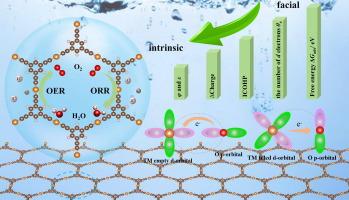基于单一过渡金属锚定石墨烯的高效OER/ORR双功能电催化剂:接受-反捐赠机制框架下的关键描述符
IF 6.9
2区 材料科学
Q2 CHEMISTRY, PHYSICAL
引用次数: 0
摘要
开发高效、非贵重、单金属原子基的析氧反应(OER)和氧还原反应(ORR)双功能电催化剂对各种能量转换装置具有重要意义。利用第一性原理计算,我们设计了一系列单一过渡金属(TM = Sc、Ti、V、Cr、Mn、Fe、Co、Ni、Cu、Zn、Nb、Mo、Ru、Rh、Pd和Pt)锚定石墨炔体系(TM- teb)。值得注意的是,Ni-TEB和Pd-TEB表现出较低的过电位(ηOER, ηORR)分别为(0.47,0.44 V)和(0.36,0.30 V),这与IrO2对OER(0.56 V)和Pt对ORR(0.45 V)的理想性能相匹配。优异的催化活性归因于活性位点与含氧中间体之间良好的相互作用,促进了催化过程中的吸附和脱附。“接受-反给予”机制有效地解释了这些相互作用,起源于适度的p-d轨道杂化,该杂化控制着TM和吸附氧原子之间的电子转移和再分配。这可以通过表面-本征描述符分析来定量地阐明,包括吸附自由能(ΔGads)、d电子数(θe)、ICOHP、电荷转移(ΔCharge)、φ和ε。这些有趣的结果可能会激发进一步探索双功能催化剂在能量存储和转换中的应用。本文章由计算机程序翻译,如有差异,请以英文原文为准。


High-efficient OER/ORR bifunctional electrocatalyst based on single transition-metal anchored Graphynes: Key descriptors under acceptance-backdonation mechanism framework
The development of highly efficient, nonprecious, single-metal-atom-based bifunctional electrocatalysts for oxygen evolution reaction (OER) and oxygen reduction reaction (ORR) is of great significance for various energy conversion devices. Using the first-principles calculations, we have designed a series of single transition metal (TM = Sc, Ti, V, Cr, Mn, Fe, Co, Ni, Cu, Zn, Nb, Mo, Ru, Rh, Pd and Pt) anchored graphyne systems (TM-TEB). Notably, Ni-TEB and Pd-TEB emerge as promising candidates for OER/ORR bifunctional electrocatalysts, exhibiting lower overpotentials (ηOER, ηORR) of (0.47, 0.44 V) and (0.36, 0.30 V), respectively, which rival ideal performance of IrO2 for OER (0.56 V) and Pt for ORR (0.45 V). The superior catalytic activity is attributed to the favorable interactions between the active sites and the oxygen-containing intermediates, facilitating the adsorption and desorption during the catalytic process. The “acceptance-backdonation” mechanism effectively explains these interactions, originating from the moderate p-d orbital hybridization that governs electron transfer and redistribution between TM and adsorbed oxygen atom. This can be quantitatively elucidated through the surface-to-intrinsic descriptors analysis, including adsorption free energy (ΔGads), the number of d electrons (θe), ICOHP, charge transfer (ΔCharge), φ and ε. These intriguing results may inspire further exploration of bifunctional catalysts for energy storage and conversion applications.
求助全文
通过发布文献求助,成功后即可免费获取论文全文。
去求助
来源期刊

Applied Surface Science
工程技术-材料科学:膜
CiteScore
12.50
自引率
7.50%
发文量
3393
审稿时长
67 days
期刊介绍:
Applied Surface Science covers topics contributing to a better understanding of surfaces, interfaces, nanostructures and their applications. The journal is concerned with scientific research on the atomic and molecular level of material properties determined with specific surface analytical techniques and/or computational methods, as well as the processing of such structures.
 求助内容:
求助内容: 应助结果提醒方式:
应助结果提醒方式:


